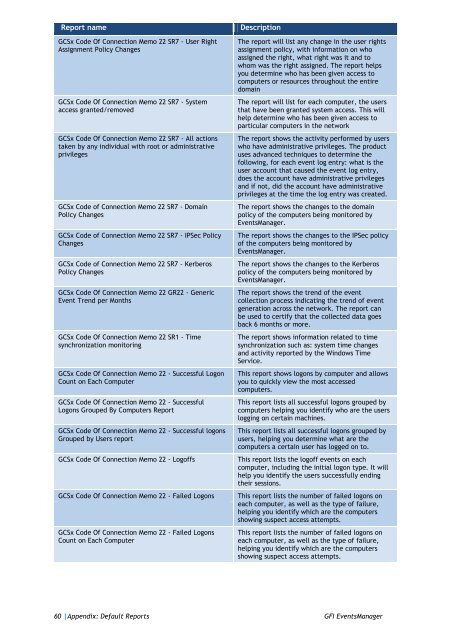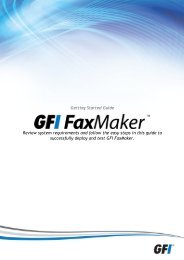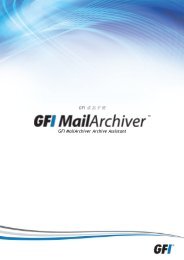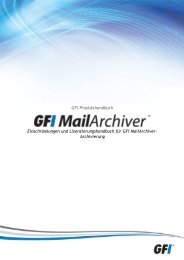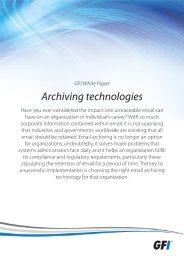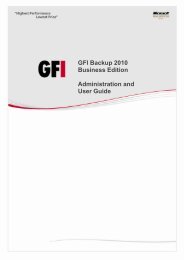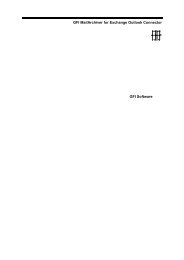ReportPack User Manual - GFI.com
ReportPack User Manual - GFI.com
ReportPack User Manual - GFI.com
Create successful ePaper yourself
Turn your PDF publications into a flip-book with our unique Google optimized e-Paper software.
Report name<br />
GCSx Code Of Connection Memo 22 SR7 - <strong>User</strong> Right<br />
Assignment Policy Changes<br />
GCSx Code Of Connection Memo 22 SR7 - System<br />
access granted/removed<br />
GCSx Code Of Connection Memo 22 SR7 - All actions<br />
taken by any individual with root or administrative<br />
privileges<br />
GCSx Code of Connection Memo 22 SR7 - Domain<br />
Policy Changes<br />
GCSx Code of Connection Memo 22 SR7 - IPSec Policy<br />
Changes<br />
GCSx Code of Connection Memo 22 SR7 - Kerberos<br />
Policy Changes<br />
GCSx Code Of Connection Memo 22 GR22 - Generic<br />
Event Trend per Months<br />
GCSx Code Of Connection Memo 22 SR1 - Time<br />
synchronization monitoring<br />
GCSx Code Of Connection Memo 22 - Successful Logon<br />
Count on Each Computer<br />
GCSx Code Of Connection Memo 22 - Successful<br />
Logons Grouped By Computers Report<br />
GCSx Code Of Connection Memo 22 - Successful logons<br />
Grouped by <strong>User</strong>s report<br />
GCSx Code Of Connection Memo 22 - Logoffs<br />
GCSx Code Of Connection Memo 22 - Failed Logons<br />
GCSx Code Of Connection Memo 22 - Failed Logons<br />
Count on Each Computer<br />
Description<br />
The report will list any change in the user rights<br />
assignment policy, with information on who<br />
assigned the right, what right was it and to<br />
whom was the right assigned. The report helps<br />
you determine who has been given access to<br />
<strong>com</strong>puters or resources throughout the entire<br />
domain<br />
The report will list for each <strong>com</strong>puter, the users<br />
that have been granted system access. This will<br />
help determine who has been given access to<br />
particular <strong>com</strong>puters in the network<br />
The report shows the activity performed by users<br />
who have administrative privileges. The product<br />
uses advanced techniques to determine the<br />
following, for each event log entry: what is the<br />
user account that caused the event log entry,<br />
does the account have administrative privileges<br />
and if not, did the account have administrative<br />
privileges at the time the log entry was created.<br />
The report shows the changes to the domain<br />
policy of the <strong>com</strong>puters being monitored by<br />
EventsManager.<br />
The report shows the changes to the IPSec policy<br />
of the <strong>com</strong>puters being monitored by<br />
EventsManager.<br />
The report shows the changes to the Kerberos<br />
policy of the <strong>com</strong>puters being monitored by<br />
EventsManager.<br />
The report shows the trend of the event<br />
collection process indicating the trend of event<br />
generation across the network. The report can<br />
be used to certify that the collected data goes<br />
back 6 months or more.<br />
The report shows information related to time<br />
synchronization such as: system time changes<br />
and activity reported by the Windows Time<br />
Service.<br />
This report shows logons by <strong>com</strong>puter and allows<br />
you to quickly view the most accessed<br />
<strong>com</strong>puters.<br />
This report lists all successful logons grouped by<br />
<strong>com</strong>puters helping you identify who are the users<br />
logging on certain machines.<br />
This report lists all successful logons grouped by<br />
users, helping you determine what are the<br />
<strong>com</strong>puters a certain user has logged on to.<br />
This report lists the logoff events on each<br />
<strong>com</strong>puter, including the initial logon type. It will<br />
help you identify the users successfully ending<br />
their sessions.<br />
This report lists the number of failed logons on<br />
each <strong>com</strong>puter, as well as the type of failure,<br />
helping you identify which are the <strong>com</strong>puters<br />
showing suspect access attempts.<br />
This report lists the number of failed logons on<br />
each <strong>com</strong>puter, as well as the type of failure,<br />
helping you identify which are the <strong>com</strong>puters<br />
showing suspect access attempts.<br />
60 |Appendix: Default Reports <strong>GFI</strong> EventsManager


